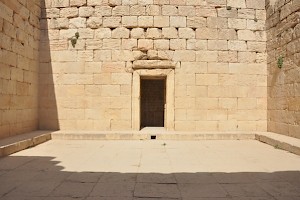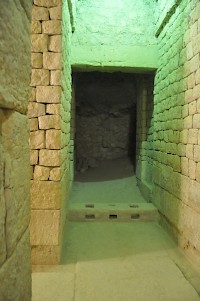Bishapur, "Temple of Anahita"
"Temple"

The building that is known as the Temple of Anahita, is in fact an unidentified structure, deeper than the other rooms of the palace. The structure, with its pleasant, harmonious dimensions, can only be reached by descending a long stairway.
It is a building without parallel. Once you've descended the stairway, you will find yourself on a small square, surrounded by high walls. The square itself must have been an undeep pool, surrounded by sidewalks. The doors in the walls give access to a corridor that surrounded the square, and which in turn gave access to the place where the aqueduct reached this square building.

On top of two of the walls, there used to be triangle-shaped structure that looks as if it supported a roof. In fact, however, the sanctuary was open, and the triangle-shaped structures supported large bull imposts. (One of these can now be seen in the Western Mosaic Hall of the Palace; see photo below.)
The big question is, of course, what this unique structure used to be. It is usually called the "Temple of Anahita", and perhaps this is correct. However, I am not betraying a great archaeological secret if I explain that when archaeologists find something they cannot understand, they usually call it religious (the "First Law of Archaeology"). Identifying a mysterious square building as a temple, is just one example. Because the ancient architect created something with water, the obvious deity would be Anahita.
However, if we give up the idea that this was a sanctuary, there is little that connects it to goddess of waters and it may well have been some kind of water garden. We simply do not know what it is.





